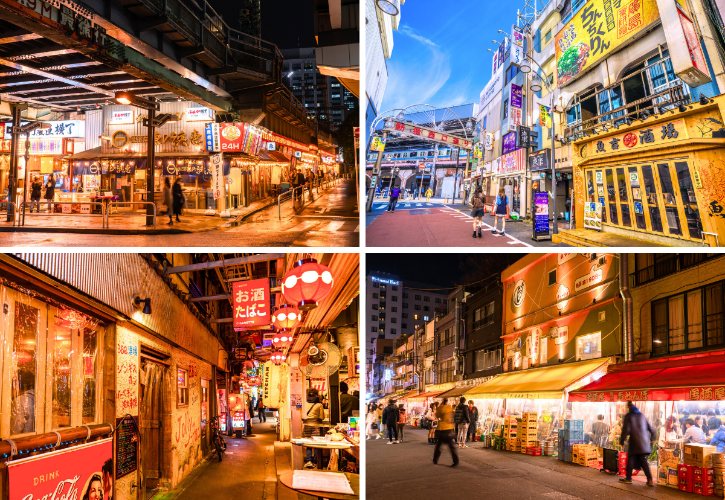
Tokyo has many famous streets, but the most interesting ones are often those travelers walk past without noticing.
These smaller lanes and old shopping arcades show how locals really eat, drink, and unwind, from lively spots under train tracks to quiet temple approaches that feel frozen in time.
Here are 10 amazing Tokyo streets most tourists miss and why each one deserves a place on your list. 😊
1. Yurakucho Sanchoku Yokocho – Izakaya Charm Beneath the Train Tracks

a. Why Visit
This alley gathers regional foods from across Japan in one compact, under-track space.
Lanterns hang low, and trains pass overhead, adding a lively rhythm to the atmosphere.
You can sit at one small shop and order dishes from other stalls, making it easy to taste many flavors in a single visit.
It is a friendly place where locals and travelers enjoy late-night meals at a relaxed pace.
b. Highlights
- Multiple themed taverns and food stalls offering a mix of seafood, meat, and regional Japanese dishes
- Casual izakaya-style setup where diners can enjoy small plates and drinks in a lively, open atmosphere
- Mix of regional flavors from Hokkaido to Kyushu, with grilled fish, pork dishes, and local-style ramen often featured
- Late-night destination popular with both office workers and travelers looking for authentic food under the railway tracks
- Comfort food favorites like kushikatsu skewers, gyoza, miso-based noodles, and slow-cooked pork belly
- Wide selection of sake and shochu from various parts of Japan, often highlighting regional breweries
c. How to Get There
From JR Yurakucho Station (Central or Ginza Exit), walk southwest along the train tracks for 5-6 minutes.
Also accessible from Hibiya Station (Metro Hibiya Line Exit A2, 4 minutes) or Ginza Station (Metro Ginza Line Exit C3, 3 minutes). Look for the entrance under the rail viaduct marked by lanterns and “産直横丁” sign.
2. Yakitori Alley (Gado-shita) – Salaryman Heaven Under the Tracks
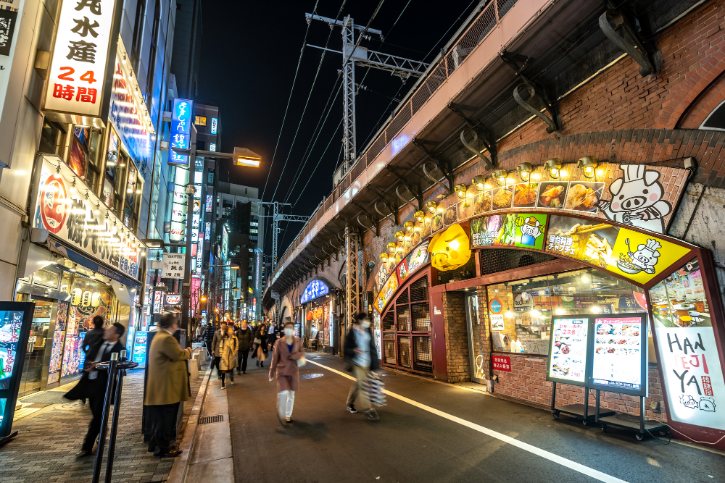
a. Why Visit
This long under-track stretch is known for its smoky grills and the casual, after-work mood that fills the air every evening.
Old wooden façades, small stools, and handwritten menus reflect the street’s post-war origins.
Office workers come here to relax over skewers and drinks, giving the alley an authentic Tokyo energy. It feels lively but approachable, perfect for a first taste of local nightlife.
b. Highlights
- Shin-Hinomoto (nicknamed “Andy’s”), a famous izakaya popular with both locals and foreigners
- Kinryo Honten, a long-established shop with prominent red lanterns and classic izakaya fare
- Hinomaru Shokudo, known for its authentic yakitori and retro izakaya vibe
- Mixed cuisines beyond yakitori including Chinese gyoza shops, Korean BBQ huts, and late-night ramen stalls
- Cozy izakaya serving hearty nikomi (beef tendon stew) that showcase Tokyo’s comforting home-style flavors
- Standing bar culture where suited workers gather around high tables with draft beer and highballs
c. How to Get There
Start from either JR Yurakucho Station (Central or Ginza Exit, 5 minutes south) or JR Shinbashi Station (Hibiya Exit, across SL Plaza with the steam locomotive).
The entire stretch under the elevated train line between these stations is filled with eateries.
3. Hoppy Street (Asakusa) – Retro Bars and Street-Style Cheers

a. Why Visit
Hoppy Street offers a cheerful, retro atmosphere where people enjoy drinks and stews at open-air tables from midday onward.
Its post-war roots give it a nostalgic charm, with vintage signs and simple dishes that feel familiar to many locals.
The area attracts a mix of older regulars, younger Tokyoites, and curious travelers. It is a relaxing place to unwind after visiting nearby Senso-ji.
b. Highlights
- Sho-chan (since 1951), visited by David Bowie, famous for perfect gyusuji nikomi
- Asakusa Sakaba Okamoto, a well-known izakaya popular with locals and tourists
- Suzuyoshi, recommended by Time Out Tokyo for hearty stews
- Izakaya Koji, specializing in ham cutlets, satsuma-age, and simmered yellowtail
- Daytime drinking culture with bars opening at noon, unlike typical nighttime-only izakayas
- Post-war black market origins with vintage Kirin signs and walls plastered with handwritten menus
c. How to Get There
Tsukuba Express Asakusa Station (Exit A1) is closest, just 1-2 minutes walk.
From Tokyo Metro Ginza Line or Toei Asakusa Line Asakusa Station, walk through Senso-ji grounds (10 minutes).
4. Kichijoji Sunroad & Harmonica Yokocho — From Daytime Shopping Street to Nighttime Maze
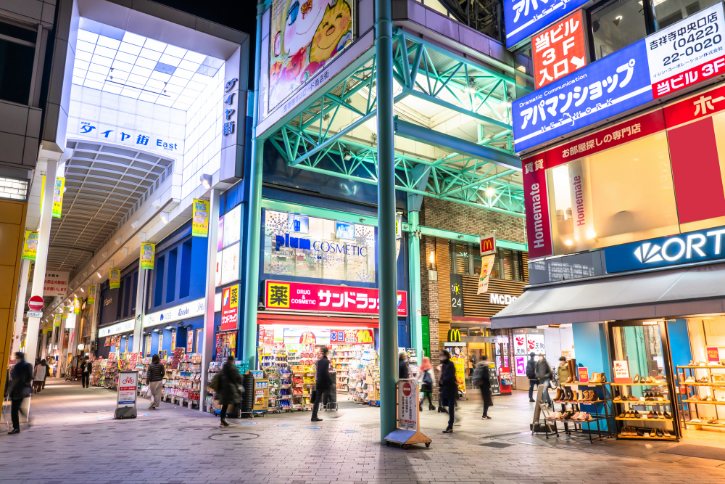
a. Why Visit
Begin your walk along Kichijoji Sunroad Shopping Street, a lively covered arcade lined with family-run shops, bakeries, and long-standing local boutiques.
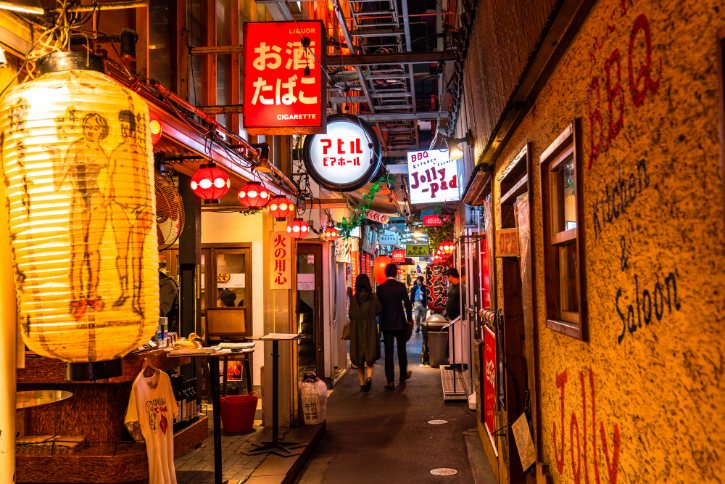
Just steps away, Harmonica Yokocho reveals a completely different side of Kichijoji, where narrow alleys shift from calm daytime markets to lively nighttime hangouts.
In the morning, fishmongers and fruit sellers fill the lanes; by evening, more than 100 tiny bars and eateries light up the maze as locals gather for yakitori, drinks, and late-night chatter.
b. Highlights
- Yakitori Tecchan, legendary spot so popular it spawned multiple branches within the alley
- Amane wagashi shop, selling traditional taiyaki and sweets since the Showa period
- Tachi Sushi Yokocho, popular standing sushi bar for quick, quality meals
- Mifune and Apron izakayas, classic spots capturing the alley’s retro atmosphere
- Chinrai-tei ramen corner, serving brothless abura soba and traditional shoyu ramen
- Kopanda Bar, known for its famous potato salad with smoked egg
c. How to Get There
JR Kichijoji Station (Chuo or Keio Inokashira Line) North Exit is just 1 minute away. The alleys span one block between Sunroad arcade and the pedestrian street to Inokashira Park.
5. Jizo Dori Shopping Street (Sugamo) – Grandma’s Harajuku for Health and Luck
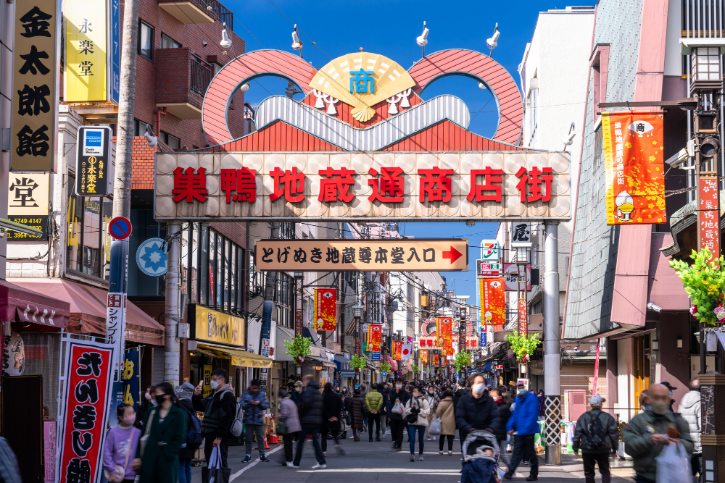
a. Why Visit
Known as “Grandma’s Harajuku”, this 800-meter street caters to seniors with traditional wares and health products, creating a nostalgic atmosphere unlike anywhere else in Tokyo.
The famous red underwear for good luck, healing temple statues, and classic sweets offer a culturally rich stroll through old Tokyo life.
b. Highlights
- Koganji Temple with the “Togenuki Jizo” statue and “Washing Kannon” for healing prayers
- Maruji store, the epicenter for lucky red underwear (aka-pantsu) and fundoshi
- Mizuno shop (since 1937), legendary for perfect shio-daifuku mochi
- Raijindo cracker shop, selling warm, chewy nure-senbei fresh from the griddle
- Sugamo Tokiwa Shokudo, serving Tokyo’s best aji fry
- Isoage at Isoage Maruten, serving delicious fried fish cakes on skewers with popular flavors like octopus with ginger or shrimp with mayonnaise
- Honeycomb Ice Cream at Sugi Honey Shop, creamy vanilla soft serve topped with real honeycomb and honey drizzle
- Anpan at Kifukudo, soft buns filled with sweet red bean paste from a century-old bakery, available in smooth or chunky fillings
- Ennichi fair days (4th, 14th, 24th monthly) with festival stalls and crowds
- Multi-generational appeal now attracting younger visitors for Showa retro vibes
c. How to Get There
Take JR Yamanote Line to Sugamo Station, then walk about 6 minutes to the entrance arch.
From Toei Mita Line Sugamo Station (Exit A3), the shopping street begins 2 minutes straight ahead. The street runs 800 meters between Sugamo and Koshinzuka stations.
6. Nakano Sun Mall Shopping Street – Gateway to Otaku Paradise
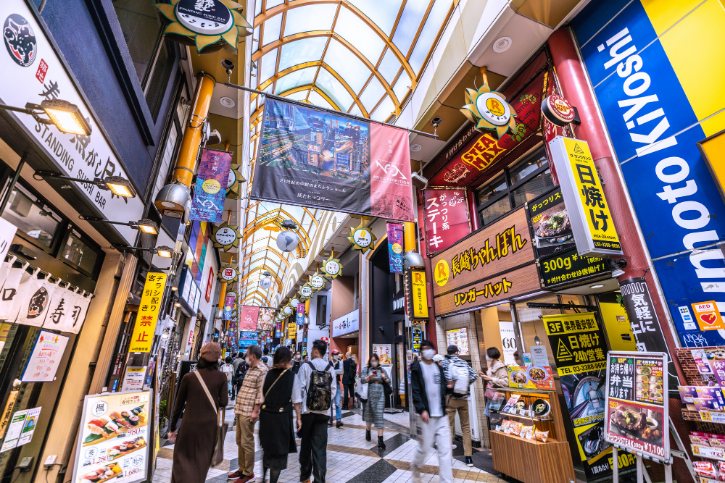
a. Why Visit
This 224-meter covered arcade serves as the bustling gateway to Nakano Broadway, mixing everyday Tokyo shopping with the lead-up to otaku heaven.
Under its bright glass canopy, 100+ shops range from rice cracker vendors to camera stores, showing regular Tokyo life before you enter the anime wonderland beyond.
b. Highlights
- Fujiya Camera, a pilgrimage spot for photography buffs with vast new and used equipment
- Daily Chiko (in Broadway basement), serving towering 8-layer soft serve with ramune and matcha
- Tsukiji Gindaco for takoyaki and traditional shops from decades past
- Nadai Unatoto Nakano, just off Sun Mall, known for its popular unagi-don
- Juke 80’s, quirky standing bar with 80s music, vinyl walls, and great yakitori
- Direct path to Nakano Broadway, the famous “mini-Akihabara” packed with Mandarake stores
c. How to Get There
JR Nakano Station (Chuo/Tozai Line) North Exit connects directly to Sun Mall. You can’t miss it; the covered arcade entrance is immediately across the station plaza.
Walk straight through for 3 minutes to reach Nakano Broadway at the far end.
7. Koenji Junjo Shotengai – Punk Rock Heritage Meets Bohemian Present
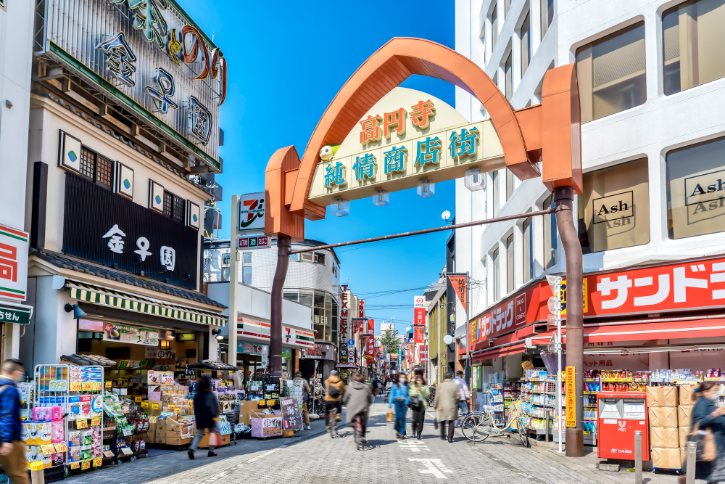
a. Why Visit
This street blends Showa-era storefronts with Koenji’s creative, bohemian spirit.
Vintage shops, small cafés, and independent bars sit side by side, creating a relaxed but energetic mood.
Live music, art events, and countercultural groups add color to the area.
It is an easy place to explore on foot, especially if you enjoy unique fashion or local subculture.
b. Highlights
- Koenji Bakushu Kobo (Beer Workshop), pioneering microbrewery with DIY bacon grilling
- The Gate, specializing in used rock clothing and vintage fashion
- Clouds Art + Coffee, combining gallery space with independent coffee culture
- Bar 365, with decor inspired by Cambodia’s Benmeria ruins
c. How to Get There
JR Koenji Station (North Exit) leads directly to the shotengai under a bright red arch.
8. Togoshi Ginza Shopping Street – Tokyo’s Longest Food Paradise
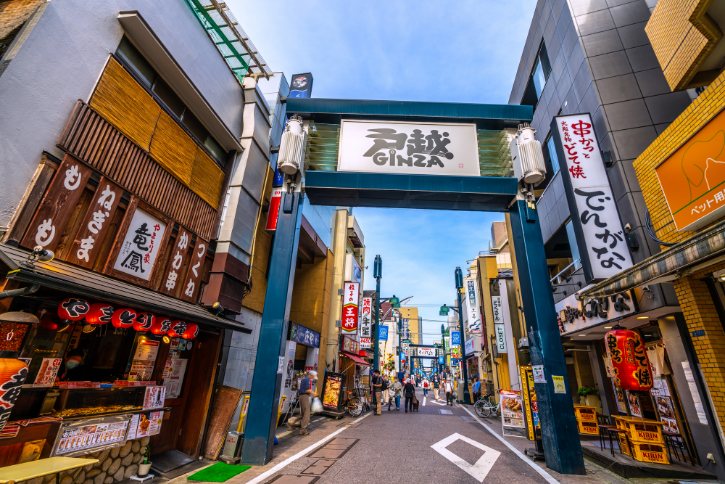
a. Why Visit
Stretching 1.3 km, this street is one of Tokyo’s best places for walking and snacking.
Locals shop for daily goods while visitors try croquettes, senbei, and sweets straight from long-running family shops.
The atmosphere is friendly and down-to-earth, with vendors eager to chat or offer recommendations.
Its length and variety make it a fun destination for anyone who likes casual food exploring.
b. Highlights
- Goto Kamaboko-ten, selling the unique oden croquette mixing oden broth with potato
- TORI&DELI, known for gluten-free karaage and jumbo chicken cutlets
- Nakamura Tadashi Shoten, a long-standing butcher shop famous for freshly fried korokke and juicy menchi katsu at wallet-friendly prices
- Onigiri Togoshiya, a gourmet rice ball shop crafting each onigiri to order with premium rice and fillings like soy sauce–marinated egg yolk with minced meat, plus its popular Togoshi Maru fried chicken side
- Hokkaido Otofuke Gyoza no Houei, celebrated for its juicy, garlic-scented fried gyoza and quirky Camembert cheese soft-serve
- Unagi Imo Store, offering soft-serve ice cream made from sweet potato with a distinct umami sweetness
- Nakatsu Karaage Kei, serving crispy, bite-size karaage perfect as a takeaway street snack
- Omedo Taiyaki-hompo, specializing in freshly baked fish-shaped taiyaki filled with sweet red bean paste
c. How to Get There
Accessible from both ends: Toei Asakusa Line Togoshi Station (east end, 1 minute) or Tokyu Ikegami Line Togoshi Ginza Station (west end, 1 minute). The street is pedestrian-friendly and mostly closed to cars.
9. Shinbashi Nishiguchi Street – Where Tokyo’s Business Heart Unwinds
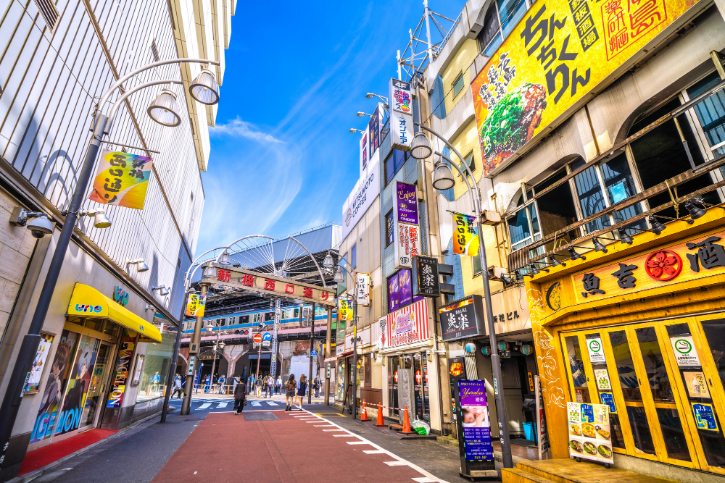
a. Why Visit
In “Salaryman Town” Shinbashi, the west side of the station is a labyrinth of bars and izakayas where Tokyo’s business world lets loose after 5pm.
Neon signs, paper lanterns, and animated conversation fill narrow alleys as office workers flock here for cheap drinks and tasty bites.
b. Highlights
- Yakiton Makotchan, beloved for secret-sauce marinated pork skewers
- Nandokiya, 24-hour izakaya famous for beef bowls
- Hinomaru Shokudo, originating from post-war stalls, noted for authentic yakitori
- Shinbashi Yokocho, new 24-hour complex with regional izakayas and shamisen shows
- Hinomarushokudo Shinbashi Sohonten, a lively izakaya best known for its charcoal-grilled yakitori and signature stone-grilled offal served sizzling on hot plates
- Kissa Fuji, a nostalgic kissaten capturing the Showa spirit with a panoramic Mount Fuji mural, fluffy pancakes, and Fujinomiya yakisoba
- Hekkelun, a beloved retro café run by an elderly couple, famed for its silky, oversized custard pudding that has become a local legend
- Hidden snack bars in upper floors, part of Shinbashi’s long-standing entertainment culture
c. How to Get There
JR Shinbashi Station Karasumori Exit leads directly to the area. The alleys are immediately outside, 1-3 minutes walk. Multiple train lines converge here: JR Yamanote, Keihin-Tohoku, Tokyo Metro Ginza Line, and Toei Asakusa Line.
10. Shibamata Taishakuten Sando – Tora-san’s Timeless Temple Street

a. Why Visit
This 200-meter street in northeast Tokyo is a perfectly preserved Showa-era time capsule, famous as the hometown of beloved film character Tora-san.
The temple approach escaped war damage, keeping wooden merchant shops and traditional sweet stalls unchanged for decades.
b. Highlights
- Takagiya Roho and Toraya, century-old shops selling famous kusa dango (mugwort dumplings)
- Kanekoya, hand-toasting senbei rice crackers with irresistible aromas
- Kawachiya, renowned for charcoal-grilled unagi over secret tare sauce
- Bronze Tora-san statue at station and Tora-san Museum showcasing film history
- Taishakuten Temple (founded 1629) with intricate Rokkakudo wood carvings
- Yamamoto-tei, preserved 1920s villa with tatami tea room and garden views
c. How to Get There
Take Keisei Kanamachi Line to Shibamata Station. The sando begins directly outside the station, just 2 minutes’ walk past the Tora-san statue. The 200-meter street leads straight to Taishakuten Temple.
Related Posts
Photo Credit:
Photos by PIXTA

